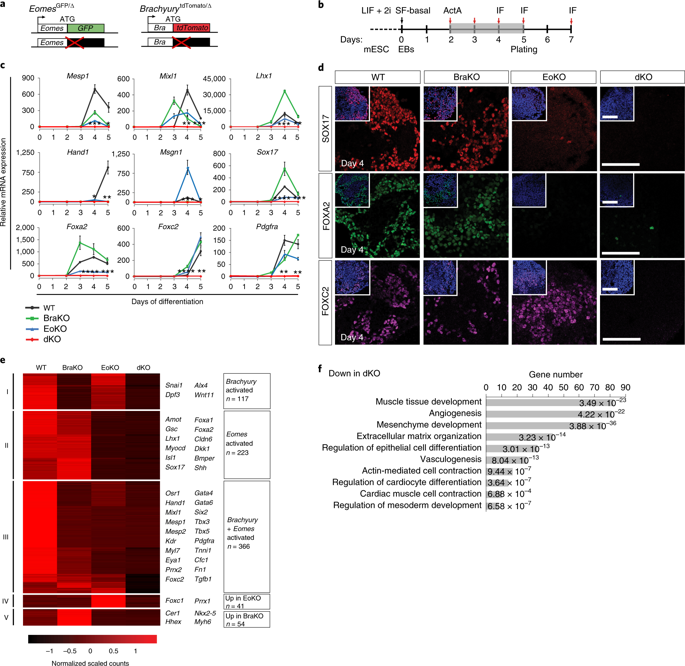当前位置:
X-MOL 学术
›
Nat. Cell Biol.
›
论文详情
Our official English website, www.x-mol.net, welcomes your
feedback! (Note: you will need to create a separate account there.)
Eomes and Brachyury control pluripotency exit and germ-layer segregation by changing the chromatin state.
Nature Cell Biology ( IF 17.3 ) Pub Date : 2019-12-02 , DOI: 10.1038/s41556-019-0423-1 Jelena Tosic 1, 2, 3 , Gwang-Jin Kim 1 , Mihael Pavlovic 1 , Chiara M Schröder 1, 2, 3, 4 , Sophie-Luise Mersiowsky 1 , Margareta Barg 1 , Alexis Hofherr 5 , Simone Probst 1 , Michael Köttgen 4, 5 , Lutz Hein 1, 4 , Sebastian J Arnold 1, 4
Nature Cell Biology ( IF 17.3 ) Pub Date : 2019-12-02 , DOI: 10.1038/s41556-019-0423-1 Jelena Tosic 1, 2, 3 , Gwang-Jin Kim 1 , Mihael Pavlovic 1 , Chiara M Schröder 1, 2, 3, 4 , Sophie-Luise Mersiowsky 1 , Margareta Barg 1 , Alexis Hofherr 5 , Simone Probst 1 , Michael Köttgen 4, 5 , Lutz Hein 1, 4 , Sebastian J Arnold 1, 4
Affiliation

|
The first lineage specification of pluripotent mouse epiblast segregates neuroectoderm (NE) from mesoderm and definitive endoderm (ME) by mechanisms that are not well understood. Here we demonstrate that the induction of ME gene programs critically relies on the T-box transcription factors Eomesodermin (also known as Eomes) and Brachyury, which concomitantly repress pluripotency and NE gene programs. Cells deficient in these T-box transcription factors retain pluripotency and differentiate to NE lineages despite the presence of ME-inducing signals transforming growth factor β (TGF-β)/Nodal and Wnt. Pluripotency and NE gene networks are additionally repressed by ME factors downstream of T-box factor induction, demonstrating a redundancy in program regulation to safeguard mutually exclusive lineage specification. Analyses of chromatin revealed that accessibility of ME enhancers depends on T-box factor binding, whereas NE enhancers are accessible and already activation primed at pluripotency. This asymmetry of the chromatin landscape thus explains the default differentiation of pluripotent cells to NE in the absence of ME induction that depends on activating and repressive functions of Eomes and Brachyury.
中文翻译:

Eomes 和 Brachyury 通过改变染色质状态来控制多能性出口和胚层分离。
多能小鼠外胚层的第一个谱系规范通过尚不清楚的机制将神经外胚层 (NE) 与中胚层和定形内胚层 (ME) 分开。在这里,我们证明 ME 基因程序的诱导严重依赖于 T-box 转录因子 Eomesodermin(也称为 Eomes)和 Brachyury,它们同时抑制多能性和 NE 基因程序。尽管存在 ME 诱导信号转化生长因子 β (TGF-β)/Nodal 和 Wnt,但缺乏这些 T-box 转录因子的细胞仍保持多能性并分化为 NE 谱系。多能性和 NE 基因网络还受到 T-box 因子诱导下游的 ME 因子的抑制,表明程序调节中存在冗余,以保护相互排斥的谱系规范。染色质分析表明,ME 增强子的可及性取决于 T-box 因子结合,而 NE 增强子是可访问的,并且已经在多能性时激活。因此,染色质景观的这种不对称性解释了在没有 ME 诱导的情况下多能细胞默认分化为 NE,这取决于 Eomes 和 Brachyury 的激活和抑制功能。
更新日期:2019-12-02
中文翻译:

Eomes 和 Brachyury 通过改变染色质状态来控制多能性出口和胚层分离。
多能小鼠外胚层的第一个谱系规范通过尚不清楚的机制将神经外胚层 (NE) 与中胚层和定形内胚层 (ME) 分开。在这里,我们证明 ME 基因程序的诱导严重依赖于 T-box 转录因子 Eomesodermin(也称为 Eomes)和 Brachyury,它们同时抑制多能性和 NE 基因程序。尽管存在 ME 诱导信号转化生长因子 β (TGF-β)/Nodal 和 Wnt,但缺乏这些 T-box 转录因子的细胞仍保持多能性并分化为 NE 谱系。多能性和 NE 基因网络还受到 T-box 因子诱导下游的 ME 因子的抑制,表明程序调节中存在冗余,以保护相互排斥的谱系规范。染色质分析表明,ME 增强子的可及性取决于 T-box 因子结合,而 NE 增强子是可访问的,并且已经在多能性时激活。因此,染色质景观的这种不对称性解释了在没有 ME 诱导的情况下多能细胞默认分化为 NE,这取决于 Eomes 和 Brachyury 的激活和抑制功能。











































 京公网安备 11010802027423号
京公网安备 11010802027423号